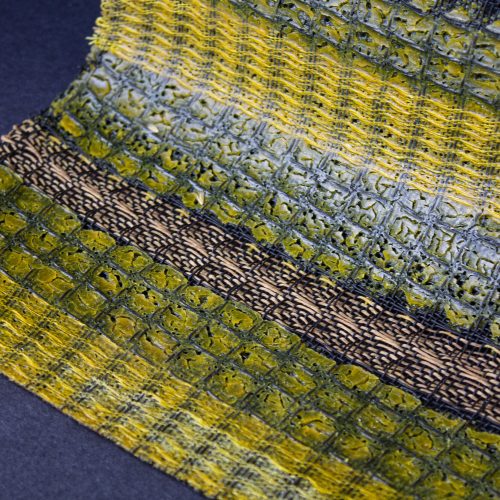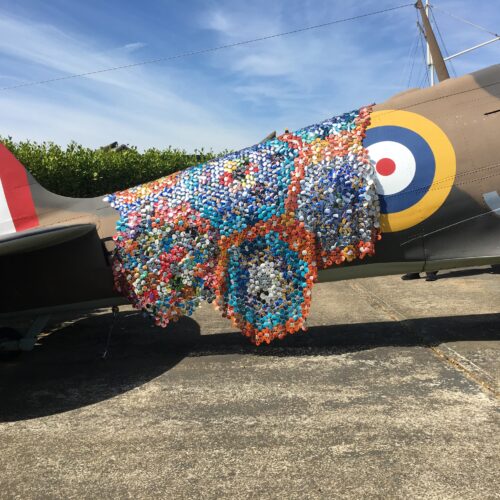
Woven Textiles exploring sustainable and waste materials
According to material innovation company Bolt Threads there are only thirty-one types of fibre in the world, with the last one created around the end of World War Two. Since this time, no new fibres have really emerged so and the textile industry market is constantly hungry and seeking innovation within fibres and fabrics. The textiles and fashion industry is second only to the oil industry in terms of the huge amount of pollution created from production and manufacture, and it needs real change to become sustainable in terms of the effects on the environment and being sensitive to kinder production within the design supply chain. I wanted to write a blog post that shines a little spotlight on some contemporary practitioners who are creating the innovative fabrics the industry is so desperate for whilst also using sustainable fibres and waste material, to push traditional weaving techniques and create exciting fabrics.

Diana Scherer is a visual artist who manipulates plant roots through various interventions to investigate the desire of humans to control nature. The beautiful, delicate fabrics that she harvests are not woven in a traditional sense, but woven organically by roots curling and tangling together. Whilst some fabrics do not go as planned, often she finds beauty in unexpected results which is surely a very healthy way of approaching a practice using a relatively unpredictable media of a growing plant (but- to my students reading this, something to be embraced across whichever media you use!). I have attached a link to a short video with an interview with the artist which shows in greater detail the delicacy of her woven pieces. https://www.youtube.com/watch?v=ySuzQ5TE3Eo

Kate Whitehead is a textile artist concerned with salvaging the discarded and ‘mending’ existing fabrics through weave and stitch. Her woven fabrics explore the idea of ‘protesting against how textiles are consumed in the western world’ and through repurposing fibres and existing fabrics, her work is also a discovery of surface, colour and tactility. There has been a great shift in clothes and fabrics been mended or repurposed instead of sending to landfill, and I find it really fascinating what can be done with an existing material instead of using new.


Alicia Rowbotham explores a variety of processes centred around sustainability and recycling through her woven fabrics. In her project ‘Zero Trace’, she investigates the use of vegetable based bio-plastics combined with biodegradable fibres in a bid to question if fabrics can have a biological lifespan. At first glance you may not think that anything other than traditional weaving yarns have been used in her work, but she uses them in a very sensitive and intelligent way. I also really admire that these fabrics would fully disintegrate if composted, not only from am eco point of view, but that the work takes on a different quality in that it is more temporary. In her project, ‘Waste Not Want Not’, Rowbotham has forged connections with textile mills to take their extensive mill waste and re-imagine it into couture fabrics, which benefits both designer and industry.


Elvis and Kresse use hand-weaving techniques in a more modular approach to weave together discarded leather (from the fashion house Burberry) as a fabric to combine with discarded, patch worked firehoses from the London Fire Brigade. This fabric, along with discarded parachute fabrics, is then made into high end apparel. It is a brilliant use of offcuts and like Rowbotham’s connection to the mills, another huge benefit to the fashion industry if something can be done with the tonnes of materials they discard. There is a link to their process here https://www.youtube.com/watch?v=h2wqEt4SUlQ

Two more artists of note are Hanna Korvela and Louise Mok; the latter using hand weaving and knotting techniques to transform found rope and denim, and the former who has built a very successful carpet business exploring traditional Scandinavian weaving techniques using an abundance of paper yarn.

I personally find these artists very inspiring and hope that their work makes you think about ways that you could perhaps be more innovative with the fabrics and yarns around you, those that would be discarded, or even just to appreciate the innovation in pushing a very old, traditional textiles technique forward.
https://www.youtube.com/watch?v=h2wqEt4SUlQ
https://www.youtube.com/watch?v=ySuzQ5TE3Eo
|
|







great post Faye – love that I find a bit support for my bioplastic samples here./Inger
Thank you, Inger! Look forward to hearing about that in the next tutorial- we can exchange intel as I too have been making bio plastics recently!
Diana Sherer’s work is very inspiring! Also The link to short videos for V&A exhibition Fashioned from Nature. This topic is timely for me, as I have just attended a short course to extract fiber out of bark.
Other artists’ works introduced here also offer me a lot of clues for my future project, as I aim to establish a kind of community development/ social business project in a rural area in Africa where resource is very limited, in which producers can feel joy of creation and consumers buy the products not out of pity but the products are beautiful.
Thank you very much for this post!
You are welcome, it’s timely in so many ways at he moment isn’t it? That sounds very exciting! I would love to see your extracted fibres if you can share a link? Or feel free to email me at fayehall@oca.ac.uk
Great blog!